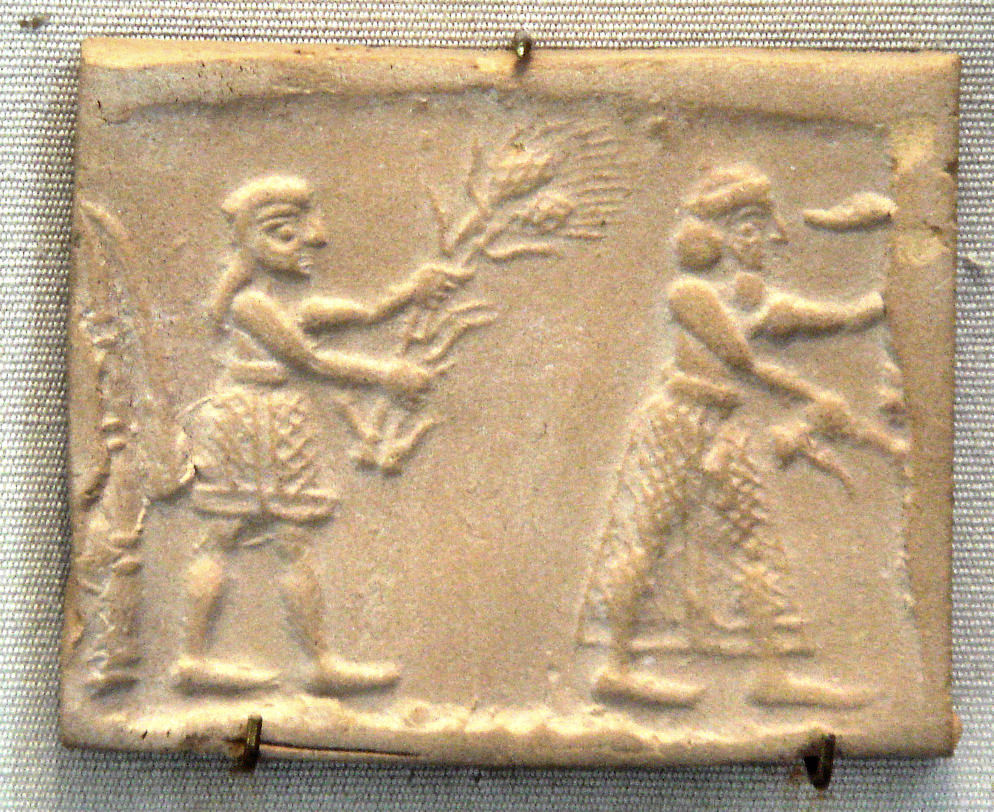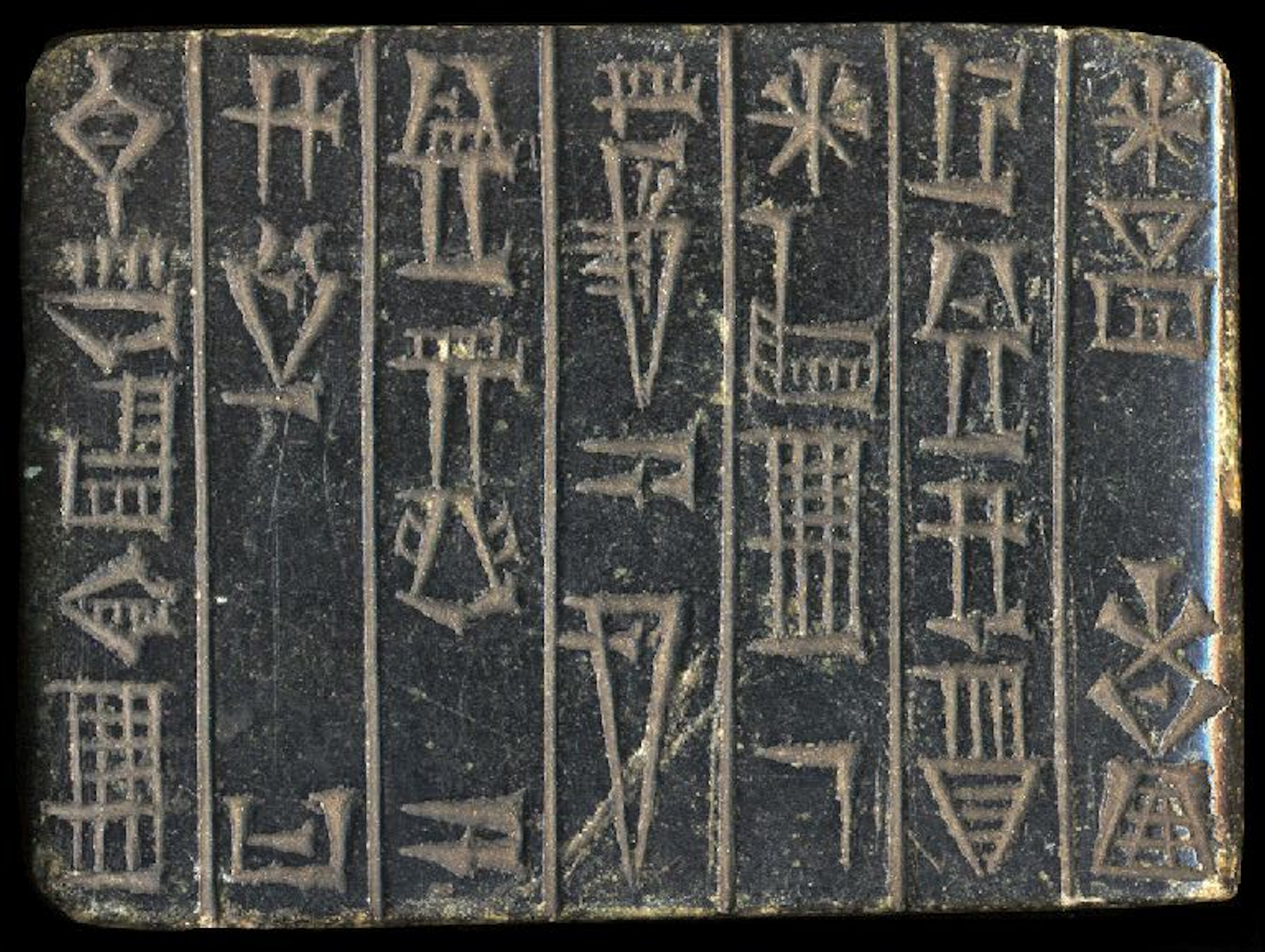|
Enannatum II
Enannatum II ( sux, , ), son of Entemena, was '' Ensi'' (governor) of Lagash. Only a few inscriptions of Enannatum II are known, suggesting a short reign. One of these inscriptions, of which four nearly identical instances are known, appears on a door socket from the great storehouse of Ningirsu at Lagash, which he restored: He had a son named Lummadur, the last representative of the house of Ur-Nanshe, who apparently never held an official title. It seems that the power of Lagash waned at this point, and that other territories such as Umma ("Gishban") and Kish prevailed. Enannatum II was the last member of the family of Ur-Nanshe. He was succeeded by a priest named Enentarzi. File:Inscribed head of a mace with Imdugud (Anzu) and Enannatum, the British Museum, London..JPG, Inscription on the mace head, possibly dedicated to Enannatum II: "For Ningirsu of E-ninnu, the workman of Enannatum, ruler of Lagash, Barakisumun, the ''sukkal'', dedicated this for the life of Enanna ... [...More Info...] [...Related Items...] OR: [Wikipedia] [Google] [Baidu] |
Lagash
Lagash (cuneiform: LAGAŠKI; Sumerian: ''Lagaš''), was an ancient city state located northwest of the junction of the Euphrates and Tigris rivers and east of Uruk, about east of the modern town of Ash Shatrah, Iraq. Lagash (modern Al-Hiba) was one of the oldest cities of the Ancient Near East. The ancient site of Nina (Tell Zurghul) is around away and marks the southern limit of the state. Nearby Girsu (modern Telloh), about northwest of Lagash, was the religious center of the Lagash state. Lagash's main temple was the E-ninnu, dedicated to the god Ningirsu. Lagash seems to have incorporated the ancient cities of Girsu, Nina, Uruazagga and Erim. History From inscriptions found at Girsu such as the Gudea cylinders, it appears that Lagash was an important Sumerian city in the late 3rd millennium BC. It was at that time ruled by independent kings, Ur-Nanshe (24th century BC) and his successors, who were engaged in contests with the Elamites to the east and the kings of '' ... [...More Info...] [...Related Items...] OR: [Wikipedia] [Google] [Baidu] |
Entemena
Entemena, also called Enmetena ( sux, , ), lived circa 2400 BC, was a son of En-anna-tum I, and he reestablished Lagash as a power in Sumer. He defeated Il, king of Umma, in a territorial conflict, through an alliance with Lugal-kinishe-dudu of Uruk, successor to Enshakushanna, who is in the king list. The tutelary deity Shul-utula was his personal deity. According to Jones (2012), his rule lasted 29 years. Territory Entemena of Lagash controlled the cities of southern Mesopotamia, from Badtibira to Uruk: Alliance treaty The most remarkable document in which he is mentioned is a clay nail found in Girsu and commemorating the alliance which he concluded with Lugal-kinishe-dudu of Uruk, the oldest mention of a peace treaty between two kings that we know: Deena Ragavan, Cuneiform Texts and Fragments in the Harvard Art Museum / Arthur M ... [...More Info...] [...Related Items...] OR: [Wikipedia] [Google] [Baidu] |
Enentarzi
Enentarzi (, ''en-en₃-tar-zid'', also , ''en-e-tar-zi'' was '' Ensi'' (governor) of Lagash. He was originally a chief-priest of Lagash for the god Ningirsu. He succeed Enannatum II who only had a short reign and was the last representative of the house of Ur-Nanshe. It seems that the power of Lagash waned at this point, and that other territories such as Umma ("Gishban") and Kish prevailed. Enentarzi probably ruled for at least 4 years. An inscription records that 600 Elamites came to plunder Lagash during the rule of Enentarzi, but that they were repelled. He was succeeded by another priest named Enlitarzi, and then his son Lugalanda Lugalanda, also Lugal-anda ( sux, ) was a Sumerian king of Lagash during the 24th century BC. Lugalanda was the son of the high priest of Lagash, who appointed him as king. At this time the high priests of Lagash were very influential, and ei .... References Kings of Lagash 25th-century BC Sumerian kings {{AncientNearEas ... [...More Info...] [...Related Items...] OR: [Wikipedia] [Google] [Baidu] |
Ensi (Sumerian)
Ensi (cuneiform: , "lord of the plowland"; Emesal dialect: ''umunsik''; akk, iššakkum, script=Latn, italic=yes) was a Sumerian title designating the ruler or prince of a city-state. Originally it may have designated an independent ruler, but in later periods the title presupposed subordinance to a lugal. For the Early Dynastic Period (about 2800–2350 BC), the meaning of the titles en, ensi and lugal cannot be differentiated clearly: see lugal, ensi and en for details. Ensi may have originally been a designation of the ruler restricted to Lagash and Umma. The ''ensi'' was considered a representative of the city-state's patron deity. In later periods, an ensi was normally seen as subordinate to a lugal. Nevertheless, even the powerful rulers of the Second Dynasty of Lagash (c. 2100 BC) such as Gudea were satisfied with the title ensi. During the Third Dynasty of Ur (about 2100–2000 BC) ensi referred to the provincial governors of the kingdom. These exercised great pow ... [...More Info...] [...Related Items...] OR: [Wikipedia] [Google] [Baidu] |
Ningirsu
, image= Cropped Image of Carving Showing the Mesopotamian God Ninurta.png , caption= Assyrian stone relief from the temple of Ninurta at Kalhu, showing the god with his thunderbolts pursuing Anzû, who has stolen the Tablet of Destinies from Enlil's sanctuary ( Austen Henry Layard ''Monuments of Nineveh'', 2nd Series, 1853) , parents=Enlil and Ninhursag As Urash, An , deity_of=God of agriculture, hunting, and war , abode=Eshumesha temple in NippurLater Kalhu, during Assyrian times , symbol=Plow and perched bird , consort= ''As Ninurta:'' Gula''As Ninĝirsu:'' Bau , children= , planet=Saturn, Mercury , mount= Beast with the body of a lion and the tail of a scorpion , equivalent1_type = Caananite , equivalent1 = Attar , equivalent2_type = Eblaite , equivalent2 = Aštabi Ninurta ( sux, : , possible meaning "Lord fBarley"), also known as Ninĝirsu ( sux, : , meaning "Lord fGirsu"), is an ancient Mesopotamian god associated with farming, healing, hunting, law ... [...More Info...] [...Related Items...] OR: [Wikipedia] [Google] [Baidu] |
Enlil
Enlil, , "Lord f theWind" later known as Elil, is an ancient Mesopotamian god associated with wind, air, earth, and storms. He is first attested as the chief deity of the Sumerian pantheon, but he was later worshipped by the Akkadians, Babylonians, Assyrians, and Hurrians. Enlil's primary center of worship was the Ekur temple in the city of Nippur, which was believed to have been built by Enlil himself and was regarded as the "mooring-rope" of heaven and earth. He is also sometimes referred to in Sumerian texts as Nunamnir. According to one Sumerian hymn, Enlil himself was so holy that not even the other gods could look upon him. Enlil rose to prominence during the twenty-fourth century BC with the rise of Nippur. His cult fell into decline after Nippur was sacked by the Elamites in 1230 BC and he was eventually supplanted as the chief god of the Mesopotamian pantheon by the Babylonian national god Marduk. Enlil plays a vital role in the Sumerian creation myth; he sep ... [...More Info...] [...Related Items...] OR: [Wikipedia] [Google] [Baidu] |
Ensi (Sumerian)
Ensi (cuneiform: , "lord of the plowland"; Emesal dialect: ''umunsik''; akk, iššakkum, script=Latn, italic=yes) was a Sumerian title designating the ruler or prince of a city-state. Originally it may have designated an independent ruler, but in later periods the title presupposed subordinance to a lugal. For the Early Dynastic Period (about 2800–2350 BC), the meaning of the titles en, ensi and lugal cannot be differentiated clearly: see lugal, ensi and en for details. Ensi may have originally been a designation of the ruler restricted to Lagash and Umma. The ''ensi'' was considered a representative of the city-state's patron deity. In later periods, an ensi was normally seen as subordinate to a lugal. Nevertheless, even the powerful rulers of the Second Dynasty of Lagash (c. 2100 BC) such as Gudea were satisfied with the title ensi. During the Third Dynasty of Ur (about 2100–2000 BC) ensi referred to the provincial governors of the kingdom. These exercised great pow ... [...More Info...] [...Related Items...] OR: [Wikipedia] [Google] [Baidu] |
Nanshe
Nanshe ( sux, ) was a Mesopotamian goddess in various contexts associated with the sea, marshlands, the animals inhabiting these biomes, namely bird and fish, as well as divination, dream interpretation, justice, social welfare, and certain administrative tasks. She was regarded as a daughter of Enki and sister of Ningirsu, while her husband was Nindara, who is otherwise little known. Other deities who belonged to her circle included her daughter Nin-MAR.KI, as well as Hendursaga, Dumuzi-abzu and Shul-utula. In Ur she was incorporated into the circle of Ningal, while in incantations she appears alongside Ningirima or Nammu. The oldest attestations of the worship of Nanshe come from the Uruk period. Her cult center was Tell Zurghul, known in antiquity as Nina. Another place associated with her, Sirara, was likely a sacred distrinct in this city. She was also worshiped elsewhere in the state of Lagash. Sanctuaries dedicated to her existed in its eponymous capital, as well as in Gi ... [...More Info...] [...Related Items...] OR: [Wikipedia] [Google] [Baidu] |
Shulutula
Shul-utul ( sux, , ) or Shul-utula was the personal god the rulers of the Mesopotamian Ur-Nanshe dynasty of Lagash. His name means "youngling shepherd" in Sumerian. Despite his role as the personal deity of kings, Shul-utul was not regarded as a deity associated with ruling, and it possible his role was instead connected to personal luck. It is also possible that, similar to Ninshubur, he was envisioned as capable of mediating with higher ranked gods on behalf of humans under his protection. One document states that he helped kings with building temples in Girsu. He is mentioned in inscriptions in association with rulers such as Entemena and Eannatum. Shut-utul is mostly attested in association with temples of other deities. Seven foundation figurines from the Ibgal temple, which dedicated to Inanna, are assumed to be depictions of Shul-utul. He was also worshiped in Emah (Sumerian: "exalted house"), a shrine of Nanshe located in Girsu. The only certain attestation of Shul-utul ... [...More Info...] [...Related Items...] OR: [Wikipedia] [Google] [Baidu] |
Ur-Nanshe
Ur-Nanshe ( sux, , ) also Ur-Nina, was the first king of the First Dynasty of Lagash (approx. 2500 BCE) in the Sumerian Early Dynastic Period III. He is known through inscriptions to have commissioned many buildings projects, including canals and temples, in the state of Lagash,Louvre Pouysségur, Patrick , ed. "Perforated Relief of King Ur-Nanshe." Louvre Museum. Louvre Museum. Web. 13 Mar 2013.. and defending Lagash from its rival state Umma.CDLI Wiki University of Oxford, 14 Jan 2010. Web. 13 Mar 2013. He was probably not from royal lineage, being the son of Gunidu () who was recorded without an accompanying royal title. [...More Info...] [...Related Items...] OR: [Wikipedia] [Google] [Baidu] |
Umma
Umma ( sux, ; in modern Dhi Qar Province in Iraq, formerly also called Gishban) was an ancient city in Sumer. There is some scholarly debate about the Sumerian and Akkadian names for this site. Traditionally, Umma was identified with Tell Jokha. More recently it has been suggested that it was located at Umm al-Aqarib, less than to its northwest or was even the name of both cities. One or both were the leading city of the Early Dynastic kingdom of Gišša, with the most recent excavators putting forth that Umm al-Aqarib was prominent in EDIII but Jokha rose to preeminence later. History In the early Sumerian text ''Inanna's descent to the netherworld'', Inanna dissuades demons from the netherworld from taking Shara, patron of Umma, who was living in squalor. They eventually take Dumuzid king of Uruk instead, who lived in palatial opulence. Best known for its long frontier conflict with Lagash, as reported circa 2400 BC by Entemena, the city reached its zenith c. 2350 BC, u ... [...More Info...] [...Related Items...] OR: [Wikipedia] [Google] [Baidu] |







.jpg)
